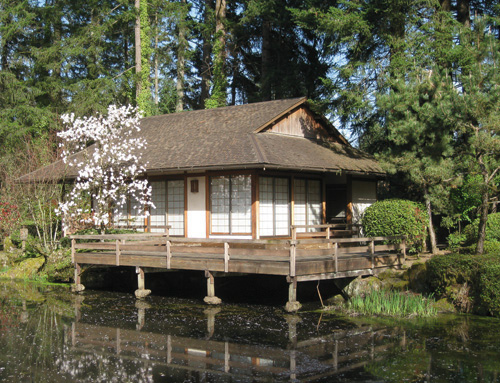 The quiet resurgence of the wood export market from Oregon to Japan is about to get a lot noisier in the wake of the devastating tsunami of March 11.
The quiet resurgence of the wood export market from Oregon to Japan is about to get a lot noisier in the wake of the devastating tsunami of March 11.
 |
The Japanese teahouse at Vanport International headquarters in Boring illustrates the use of Douglas fir in traditional Japanese buildings. // Photo courtesy Vanport International |
The quiet resurgence of the wood export market from Oregon to Japan is about to get a lot noisier in the wake of the devastating tsunami of March 11.
Oregon was a leader in log and lumber exports to Japan in the 1980s and 1990s. The business dropped off due to environmental restrictions on the logging of public lands, but it has rebounded powerfully since the recession ended. Log and lumber exports from the U.S. to Japan were up 21% to $694 million in 2010. Vanport International president Paul Owen, a long-time lumber exporter, says Douglas fir component shipments from the Northwest into Japan have been even stronger, growing by nearly 50% in 2010.
Vanport has exported to Japan since the 1970s and has been scrambling lately to keep up with Japanese demand. Owen says local mills that sell to Japan are “sold out months ahead.”
In 2010 there were 813,000 housing starts in Japan, compared to 587,000 in the U.S. The forecast for 2011 called for 870,000 new homes in Japan. That was before the tsunami hit, killing tens of thousands of people and destroying hundreds of thousands of homes and buildings. The tragedy has resulted in a short-term need for plywood and a long-term opportunity for mills able to meet Japan’s high standards for quality.
Oregon’s largest lumber producer for Japan is the 140-employee Warm Springs Forest Products mill on tribal land west of Madras. Operated by Vanport since 2008, the Warm Springs mill ships about 3 million board feet per month into Japan. Other companies around the state poised to supply Japan’s rebuilding effort are Starfire Lumber of Cottage Grove, Zip-O-Log Mills of Eugene and Portland-based Stimson Lumber. “Anyone who manufactures Douglas fir products for export will be in a strong position,” says Owen.
SDS Lumber of Bingen, Wash., in the Columbia River Gorge, recently resumed plywood shipments to Japan after a 15-year dry spell. Other timber companies still reeling from the collapse of the domestic housing market are eyeing the Japanese market with renewed interest. This includes businesses growing weary of exporting high volumes of wood at low prices into resource-hungry China. Japanese buyers pay a higher price because their building codes are strict and their needs are specific. The Japanese economy is in deep trouble, but this is a nation with a long history of recovering powerfully from catastrophes.
Ben Jacklet

